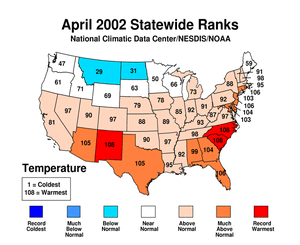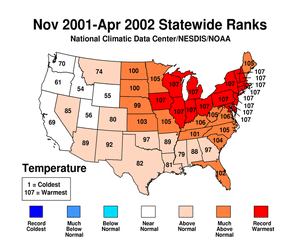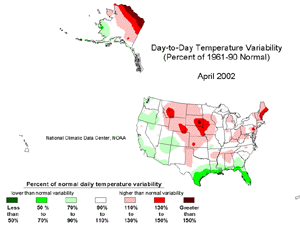National
Temperatures

larger
image
|
The graph to the left
shows monthly mean temperature averaged across the contiguous
United States based on long-term data from the U.S. Historical
Climatology Network (USHCN). The value for
2002 is estimated from preliminary Climate Division data using the
first difference approach.
April 2002 ranked as the 9th warmest April in the 1895 to present
record. The preliminary nationally averaged temperature was
54.6° F (12.6° C) which was 2.6° F (1.4° C) above
the long-term mean. The April temperature values
from 1895 through 2002 are available. |
| Record warmth occurred
in New Mexico and the Carolinas in April. The pattern of warmth and
cold in the contiguous U.S. in April corresponds well with the
mean
500mb height and anomalies chart. This shows that above normal
500mb heights existed across the entire southern tier of the U.S.,
with the largest anomalies occurring from Virginia to west Texas.
Cooler than average surface temperatures were associated with lower
than average 500mb heights in Canada and the extreme northern
portion of the north central U.S. states. The pattern of
state-averaged monthly temperature can be seen in the map to the
right.
A more detailed analysis
including how statewide and regionwide temperatures compare to
other years is available.
|

larger
image
|

larger
image
|
A map of temperatures
for the last 6 months, shows that 16 states in the northeast
quadrant of the country averaged record warmth. Very few arctic air
masses penetrated this region during the 2001-2002 winter as
compared to average, and this resulted in much above normal
temperatures for much of the season. |
Temperature Departures
| The map to the right,
based on over 500 airport stations, shows departures from the
1971-2000 normal temperatures for April 2002. Warmer than average
temperatures extended from New England to the Southwest with the
largest positive departures in the contiguous U.S. (greater than
5.4° F [3° C]) occurring in the Southeast, New Mexico,
Arizona, Colorado and parts of Texas. Negative temperature
anomalies were confined to the north central states and Alaska,
with some cooler than average temperatures also occurring in
coastal California. The most significant negative departures
occurred in southeastern Alaska where temperatures were below
average by more than 9.0°F (5.0°C). |

larger
image
|

larger
image
|
The day-to-day
variability of daily mean temperature was up to 110-150% of normal
over most Central Plains states in April. This was associated with
a series of alternating cold and warm outbreaks throughout the
month, as can be seen in an animated map
of daily temperature anomalies. Below average temperature
variability was notable along the Gulf coast where day-to-day
variability was less than 70% of average. |
National Precipitation

larger
image
|
The graph to the left
is a time series depicting precipitation averaged across the
contiguous U.S. Based upon preliminary precipitation data, April
2002 was slightly drier than average, ranking 39th driest. April
2002 marks the 3rd consecutive drier than average April, though the
last 10 years have generally been wetter than average for the month
of April. |
| There was considerable
regional variability in precipitation across the country. States in
the southern U.S. continued to receive less rainfall than average
in April, while most states in the East North Central, Central and
Northeast regions were wetter or much wetter than average.
A more detailed analysis
including how statewide and regionwide precipitation compares to
other years is available.
|

larger
image
|
Precipitation Anomalies
| The map to the right,
based on more than 500 airport stations, shows April 2002 total
precipitation as a percent of the 1971-2000 station normals. Above
normal precipitation generally occurred from Oklahoma northeast
through the Ohio Valley to northern New England, with more than
180% of normal precipitation falling in some locations. The Upper
Peninsula of Michigan also received much above normal precipitation
for the month, as did much of Alaska. The rest of the country was
mostly dry, including, most notably, southern Californa, the
Southeast and the plains just east of the Rockies. The islands of
Hawaii were also drier than normal for April. |

larger
image
|
National
Snow Cover
Snow cover
across the country generally decreased throughout the month however, there was
significant snowfall in parts of the country, including Wisconsin
and the Upper Peninsula of Michigan (see image below).
| The map to the right
shows snowfall totals in the East North Central region of the U.S.
on April 28 after a storm dumped over a foot of snow on isolated
portions of Wisconsin and Michigan's Upper Peninsula. |

larger
image
|

 NOAA's National Centers for Environmental Information
NOAA's National Centers for Environmental Information







